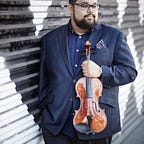Burning up on reentry
[The below is an excerpt from the liner notes of my solo violin album “When the Violin”, which was released on Bandcamp earlier this summer. If you’d like to listen to more of the album or my recordings, please visit the link. A video excerpt from the album is at the end of this essay.]
Sei Solo: you are alone.
I’ve always loved the parable of Bach as an orphaned 10 year old, copying music alone by candlelight. His guardian, his older brother, had forbidden him from learning music of an older master, so the 10 year old Sebastian snuck down in the dead of night, undid the lock of the cupboard with his little hands, and defiantly copied the music of the past. The music claimed him, as he claimed the music.
Throughout his life, Bach was no stranger to aloneness, or to grief. The violinist-scholar Andrew Manze points out the significance of Bach naming the year — 1720 — of these works for “violino solo senza basso accompagnato” — as it was not standard practice for a composer to assign their works to a specific year, in case they may want to recycle the work later in a different form, as Bach so often did. Why was 1720 different?
1720 started off as a great year. Bach was working for the Prince Leopold of Anhalt-Cöthen, himself a gifted and well-traveled musician, who allowed his new Kapellmeister to acquire a cadre of recently-unemployed virtuosos from the court in Berlin. With these musicians, Bach created many of the instrumental works we know and love today — among them the Brandenburg Concertos and the orchestral suites. Later that summer, Bach visited the famous spa and music festival at Carlsbad with the Prince (which conjures images of Bach playing chamber music by day and drinking beer in a hot spring by night), and upon his return, learned that his beloved wife Maria Barbara — his teenage sweetheart and mother of their 7 children — had been dead for four months.
What strange aloneness it must have been for Bach, to grieve out of sync with his family. Instead of being consumed by grief, Bach chose a different way. I imagine he turned to a familiar place within him — the place where he knew how to be alone, with music. I imagine that he coupled his grief with the infectious inspiration and craft he learned from his journey in Carlsbad, and poured an amalgam of expression into a nearby, quiet, four-stringed instrument. Bach metabolized his grief into something which still nourishes us.
Sei Solo. These words appear in the title page of Bach’s monumental works for unaccompanied violin. The first pronouncement of grief in this music — the note G (“Sol” for “solo”, as Manze says) — is the sound of a heart quietly breaking. In the Adagio, I imagine one taking the deep plunge into the solitary labor of putting the pieces of one’s shattered life back together again. The Fuga is a conversation with oneself towards the realization of some catharsis, some purpose in anger. The comfort of the Siciliana is tenuous and pastoral, a lullaby dance in the dark. The Presto twirls with the bones of grief, and burns up on reentry.
